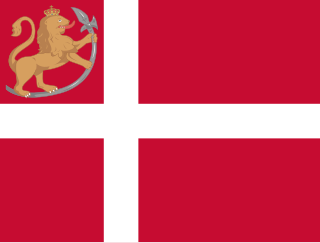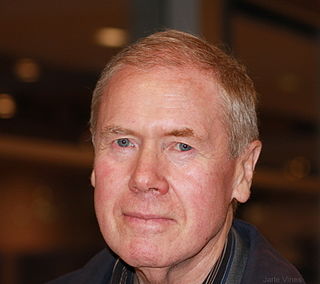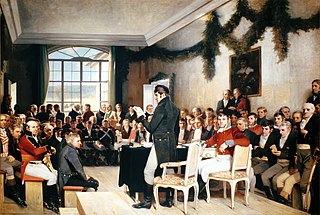
The Royal Norwegian Navy is the branch of the Norwegian Armed Forces responsible for naval operations of the state of Norway. As of 2008, the RNoN consists of approximately 3,700 personnel and 70 vessels, including 5 heavy frigates, 6 submarines, 14 patrol boats, 4 minesweepers, 4 minehunters, 1 mine detection vessel, 4 support vessels and 2 training vessels. The navy also includes the Coast Guard.
The Constitution of Norway was first adopted on 16 May and subsequently signed and dated on 17 May 1814 by the Norwegian Constituent Assembly at Eidsvoll. It was at the time considered to be one of the most liberal or radically democratic constitutions in the world, and it is today the second oldest single-document national constitution in Europe after the Constitution of Poland and second oldest in the world still in continuous force after the United States Constitution, as the Polish 3 May Constitution survived for less than 2 years. 17 May is the National Day of Norway.
Bokmål is an official written standard for the Norwegian language, alongside Nynorsk. Bokmål is the preferred written standard of Norwegian for 85% to 90% of the population in Norway. Unlike for instance the Italian language, there is no nationwide standard or agreement on the pronunciation of Bokmål.

The flag of Norway is red with an indigo blue Scandinavian cross fimbriated in white that extends to the edges of the flag; the vertical part of the cross is shifted to the hoist side in the style of the Dannebrog, the flag of Denmark.

Sweden and Norway or Sweden–Norway, officially the United Kingdoms of Sweden and Norway, or as the United Kingdoms, was a personal union of the separate kingdoms of Sweden and Norway under a common monarch and common foreign policy that lasted from 1814 until its amicable and peaceful dissolution in 1905.

In the War of the Sixth Coalition, sometimes known in Germany as the War of Liberation, a coalition of Austria, Prussia, Russia, the United Kingdom, Portugal, Sweden, Spain and a number of German States defeated France and drove Napoleon into exile on Elba. After the disastrous French invasion of Russia of 1812, the continental powers joined Russia, the United Kingdom, Portugal and the rebels in Spain who were already at war with France.
The Convention of Moss was a cease fire agreement, signed on 14 August 1814 between the Swedish King and the Norwegian government. It followed the Swedish-Norwegian War due to Norway's claim to sovereignty. It also became the de facto peace agreement and formed the basis for the personal union between Sweden and Norway that was established when the Norwegian Storting (Parliament) elected Charles XIII of Sweden as king of Norway on 4 November 1814. The Union lasted until Norway declared its dissolution in 1905.

In August 1814, after a loss in the Swedish–Norwegian War, Kingdom of Norway was forced to join in a personal union with the Kingdom of Sweden, thereby becoming subject to a naval blockade by the British Empire, but remaining largely autonomous within the union. Although nationalist aspirations were not to be fully realized until the events of 1905, 1814 was the crisis and turning point in events that would lead to a fully independent Norway.

The dissolution of the union between the kingdoms of Norway and Sweden under the House of Bernadotte, was set in motion by a resolution of the Norwegian Parliament on 7 June 1905. Following some months of tension and fear of war between the neighbouring nations – and a Norwegian plebiscite held on 13 August which overwhelmingly backed dissolution – negotiations between the two governments led to Sweden's recognition of Norway as an independent constitutional monarchy on 26 October 1905. On that date, King Oscar II renounced his claim to the Norwegian throne, effectively dissolving the United Kingdoms of Sweden and Norway, and this event was swiftly followed, on 18 November, by the accession to the Norwegian throne of Prince Carl of Denmark, taking the name of Haakon VII.
The Governor-general of Norway, styled Rigsstatholder in Danish or Riksståthållare in Swedish, both meaning 'Lieutenant of the realm', was the appointed head of the Norwegian Government in the absence of the Monarch.

The Swedish–Norwegian War, also known as the Campaign against Norway, War with Sweden 1814, or the Norwegian War of Independence, was a war fought between Sweden and Norway in the summer of 1814. The war resulted in a Swedish victory which led to Norway being forced to enter into union with Sweden, but with its own constitution and parliament under the rule of the Swedish monarch Charles XIV.

Gunnar Berge is a Norwegian politician for the Labour Party, born in Etne, Hordaland. Berge represented Rogaland in the Norwegian Parliament from 1969 to 1993. He was Minister of Finance 1986-1989, Minister of Local Government and Regional Development 1992-1997, as well as minister of Nordic Cooperation 1992-1997. After his political career he was Director General of the Norwegian Petroleum Directorate 1996-2007. He was also member of the Norwegian Nobel Committee from 1997 to 2002, as leader from 2000 to 2002.

The Norwegian Constituent Assembly is the name given to the 1814 Constitutional Assembly at Eidsvoll in Norway, that voted the Norwegian Constitution and formalised the dissolution of the union with Denmark. In Norway, it is often just referred to as Eidsvollsforsamlingen, which means The Assembly of Eidsvoll.
The Norwegian Minister of Defence is the head of the Norwegian Ministry of Defence. The position has existed since 1814. The incumbent minister since 20 October 2017 is Frank Bakke Jensen of the Conservative Party.
Events in the year 1814 in Norway.
In Norway, a State Secretary is a partisan political position within the executive branch of government. Contrary to the position Secretary of State in many other countries, the Norwegian State Secretary does not head his or her Ministry, rather, they are second in rank to a Minister. Resembling a de facto vice minister, the State Secretary, however, cannot attend a Council of State, and does not act as a temporary Minister in case of illness or other leave of absence.

Denmark–Norway relations are foreign relations between Denmark and Norway. The countries have a very long history together: they were both part of the Kalmar Union between 1397 and 1523, and Norway was in Union with Denmark between 1524 and 1814.

Denmark–Norway, also known as the Dano–Norwegian Realm, the Oldenburg Monarchy or the Oldenburg realms, was an early modern multi-national and multi-lingual real union consisting of the Kingdom of Denmark, the Kingdom of Norway, the Duchy of Schleswig, and the Duchy of Holstein. The state also claimed sovereignty over two historical peoples: Wends and Goths. Denmark–Norway had several colonies, namely the Danish Gold Coast, the Nicobar Islands, Serampore, Tharangambadi, and the Danish West Indies.
Events in the year 1658 in Norway.














